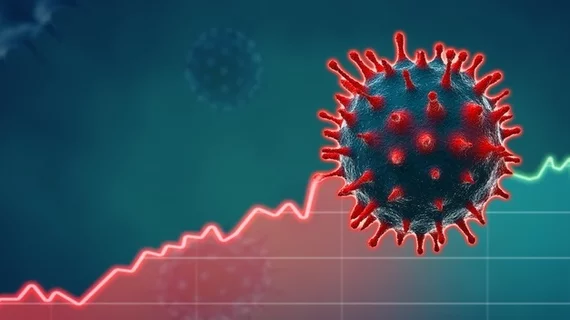Population trends in CT of the abdomen and pelvis could help predict future COVID-19 outbreaks
Population trends in imaging of the abdomen and pelvis could help predict future COVID-19 outbreaks or the arrival of new variants, according to a new analysis.
Insufficient testing supplies and asymptomatic carriers can make containment of the virus challenging. However, the rate of abnormal lung-base findings on abdominopelvic CT at NYU Langone Health has highly correlated with citywide positive testing rates for the disease, experts wrote in Academic Radiology.
“With the rise of new variants, breakthrough infection in vaccinated individuals, spread of COVID-19 infection among ‘asymptomatic’ individuals, reduced COVID-19 testing and contact tracing, the ability to provide a surrogate marker of community viral load is essential,” Paul Smereka, MD, with the New York City institution’s department of radiology, and colleagues detailed Sept. 30. “Therefore, the ability to model community infection load via unexpected imaging findings on abdominopelvic CT is useful.”
For the study, NYU scientists searched their electronic medical record for mentions of COVID-19 in abdominopelvic CT reports written between March and April of 2020. They then compared trends in concerning lung-base findings against confirmed coronavirus infections during the same time span. Smereka and co-authors found that CT trends in this patient segment mirrored rises and falls in total coronavirus cases.
In particular, 151 patients without any respiratory symptoms were discovered to have abnormal lung-base findings on abdominopelvic CT. About 35% of this group were COVID positive, 13% negative and the rest (52%) had no recorded test. Another 38 patients showed respiratory symptoms, with 63% positive for the virus, 21% negative and 16% did not receive a test. Comparing these two groups against one another, those with respiratory symptoms showed significantly higher ferritin levels (associated with more severe illness) and a higher death rate (33% versus 9 %).
A chest radiologist’s retrospective review of the original lung-base assessments confirmed they were “highly sensitive for COVID-19 or other atypical infection.”
“As specific criteria for COVID-19 lung findings become more established, machine-learning algorithms could potentially be used to monitor the rate of such findings in the population, as an early warning or surrogate measure of new or ongoing outbreaks,” the authors advised. “Future research with larger sample sizes could potentially help to produce a model in which concerning lung base findings on abdominopelvic CT are used to predict future outbreaks of COVID-19, new variant infection outbreaks, and effectiveness of containment and prevention measures,” they added later.

